Asus 2014 Annual Report Download - page 264
Download and view the complete annual report
Please find page 264 of the 2014 Asus annual report below. You can navigate through the pages in the report by either clicking on the pages listed below, or by using the keyword search tool below to find specific information within the annual report.-
 1
1 -
 2
2 -
 3
3 -
 4
4 -
 5
5 -
 6
6 -
 7
7 -
 8
8 -
 9
9 -
 10
10 -
 11
11 -
 12
12 -
 13
13 -
 14
14 -
 15
15 -
 16
16 -
 17
17 -
 18
18 -
 19
19 -
 20
20 -
 21
21 -
 22
22 -
 23
23 -
 24
24 -
 25
25 -
 26
26 -
 27
27 -
 28
28 -
 29
29 -
 30
30 -
 31
31 -
 32
32 -
 33
33 -
 34
34 -
 35
35 -
 36
36 -
 37
37 -
 38
38 -
 39
39 -
 40
40 -
 41
41 -
 42
42 -
 43
43 -
 44
44 -
 45
45 -
 46
46 -
 47
47 -
 48
48 -
 49
49 -
 50
50 -
 51
51 -
 52
52 -
 53
53 -
 54
54 -
 55
55 -
 56
56 -
 57
57 -
 58
58 -
 59
59 -
 60
60 -
 61
61 -
 62
62 -
 63
63 -
 64
64 -
 65
65 -
 66
66 -
 67
67 -
 68
68 -
 69
69 -
 70
70 -
 71
71 -
 72
72 -
 73
73 -
 74
74 -
 75
75 -
 76
76 -
 77
77 -
 78
78 -
 79
79 -
 80
80 -
 81
81 -
 82
82 -
 83
83 -
 84
84 -
 85
85 -
 86
86 -
 87
87 -
 88
88 -
 89
89 -
 90
90 -
 91
91 -
 92
92 -
 93
93 -
 94
94 -
 95
95 -
 96
96 -
 97
97 -
 98
98 -
 99
99 -
 100
100 -
 101
101 -
 102
102 -
 103
103 -
 104
104 -
 105
105 -
 106
106 -
 107
107 -
 108
108 -
 109
109 -
 110
110 -
 111
111 -
 112
112 -
 113
113 -
 114
114 -
 115
115 -
 116
116 -
 117
117 -
 118
118 -
 119
119 -
 120
120 -
 121
121 -
 122
122 -
 123
123 -
 124
124 -
 125
125 -
 126
126 -
 127
127 -
 128
128 -
 129
129 -
 130
130 -
 131
131 -
 132
132 -
 133
133 -
 134
134 -
 135
135 -
 136
136 -
 137
137 -
 138
138 -
 139
139 -
 140
140 -
 141
141 -
 142
142 -
 143
143 -
 144
144 -
 145
145 -
 146
146 -
 147
147 -
 148
148 -
 149
149 -
 150
150 -
 151
151 -
 152
152 -
 153
153 -
 154
154 -
 155
155 -
 156
156 -
 157
157 -
 158
158 -
 159
159 -
 160
160 -
 161
161 -
 162
162 -
 163
163 -
 164
164 -
 165
165 -
 166
166 -
 167
167 -
 168
168 -
 169
169 -
 170
170 -
 171
171 -
 172
172 -
 173
173 -
 174
174 -
 175
175 -
 176
176 -
 177
177 -
 178
178 -
 179
179 -
 180
180 -
 181
181 -
 182
182 -
 183
183 -
 184
184 -
 185
185 -
 186
186 -
 187
187 -
 188
188 -
 189
189 -
 190
190 -
 191
191 -
 192
192 -
 193
193 -
 194
194 -
 195
195 -
 196
196 -
 197
197 -
 198
198 -
 199
199 -
 200
200 -
 201
201 -
 202
202 -
 203
203 -
 204
204 -
 205
205 -
 206
206 -
 207
207 -
 208
208 -
 209
209 -
 210
210 -
 211
211 -
 212
212 -
 213
213 -
 214
214 -
 215
215 -
 216
216 -
 217
217 -
 218
218 -
 219
219 -
 220
220 -
 221
221 -
 222
222 -
 223
223 -
 224
224 -
 225
225 -
 226
226 -
 227
227 -
 228
228 -
 229
229 -
 230
230 -
 231
231 -
 232
232 -
 233
233 -
 234
234 -
 235
235 -
 236
236 -
 237
237 -
 238
238 -
 239
239 -
 240
240 -
 241
241 -
 242
242 -
 243
243 -
 244
244 -
 245
245 -
 246
246 -
 247
247 -
 248
248 -
 249
249 -
 250
250 -
 251
251 -
 252
252 -
 253
253 -
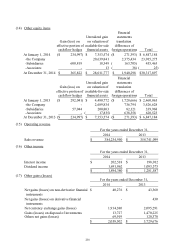 254
254 -
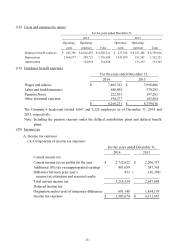 255
255 -
 256
256 -
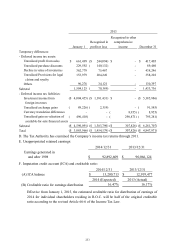 257
257 -
 258
258 -
 259
259 -
 260
260 -
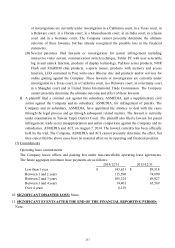 261
261 -
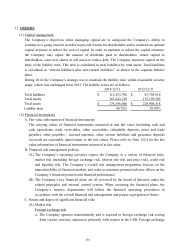 262
262 -
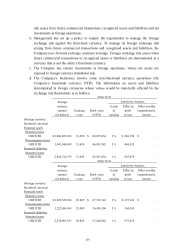 263
263 -
 264
264 -
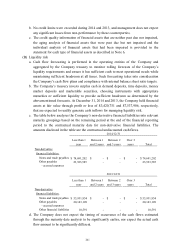 265
265 -
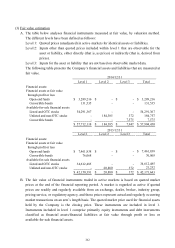 266
266 -
 267
267 -
 268
268
 |
 |

260
Price risk
a. The Company is exposed to equity securities price risk because of investments held by
the Company and classified on the separate balance sheet either as available-for-sale or
at fair value through profit or loss. To manage its price risk arising from investments in
equity securities, the Company diversifies its portfolio. Diversification of the portfolio is
done in accordance with the limits set by the Company.
b. The prices of the Company’s investments in equity securities would change due to the
change of the future value of investee companies. If the prices of these equity securities
had increased by 1% with all other variables held constant, other comprehensive income
- unrealized gain on valuation of available-for-sale financial assets for the years ended
December 31, 2014 and 2013 would have increased by $544,761 and $346,337,
respectively. The Company is exposed to equity securities price risk because of
investments held by the Company classified as available-for-sale financial assets or
financial assets at fair value through profit or loss at the separate balance sheet. The
Company is not exposed to commodity price risk. To manage equity securities price risk,
the Company diversifies its investment portfolio in accordance with the limits set by the
Company.
Interest rate risk
The Company analyses its interest rate exposure on a dynamic basis. Various scenarios are
simulated taking into consideration refinancing, renewal of existing positions, alternative
financing and hedging. Based on these scenarios, the Company calculates the impact on
profit and loss of a defined interest rate shift. For each simulation, the same interest rate
shift is used for all currencies. The scenarios are run only for liabilities that represent the
major interest-bearing positions. The Company expects no significant interest rate risk
would arise.
Credit risk
a. Credit risk refers to the risk of financial loss to the Company arising from default by the
clients or counterparties of financial instruments on the contract obligations. The
maximum exposure to credit risk at end of the financial reporting period is the carrying
amount of all financial instruments. According to the Company’s credit policy, each
local entity in the Company is responsible for managing and analysing the credit risk for
each of their new clients before standard payment and delivery terms and conditions are
offered. Internal risk control assesses the credit quality of the customers, taking into
account their financial position, past experience and other factors. Individual risk limits
are set based on internal or external ratings in accordance with limits set by the board of
directors. The utilization of credit limits is regularly monitored. Credit risk arises from
cash and cash equivalents, derivative financial instruments and deposits with banks and
financial institutions, as well as credit exposures to wholesale, including outstanding
receivables and committed transactions. For banks and financial institutions, only those
with a rating of “A” class above as evaluated by an independent party are accepted as
counterparties.
